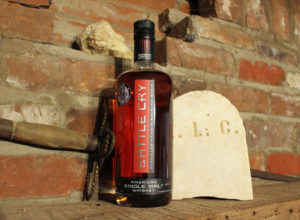By Richard Thomas
Rating: B-
Battle Cry is one of the beer-inspired American Malts coming from Rhode Island brewstillery Sons of Liberty. It’s billed as a single malt, but it’s a bit more interesting than that. Technically, a single malt is 100% malted barley and made at a single distillery. Battle Cry doesn’t quite qualify because it used a little malted rye. So, American Malt yes (American Malts need only be 51% malted barley), but under world standards it’s not a single malt. It’s aged in new white oak and bottled at 92 proof.
The Whiskey
Battle Cry has a dull copper look in the glass, like a darker, murkier rye whiskey. The coating of the glass dropped slow, skinny tears.
The nosing gave me a rich, murky scent, full of gingerbread with a hint of red fruits. On the palate, that gingerbread turned ginger cookie, and a spicier, peppery ginger cookie at that. Balancing this was some anise and more of that murky, wine-style red fruitiness. The finish stayed in that ginger, peppery vein, and lasted a decent amount of time.
Battle Cry is a simple-but-tasty whiskey, if you like your whiskey spicy. It’s very straightforward, uncomplicated, and I think it will make a pretty good choice for drinking on the rocks later this summer. That ginger spice current should hold up pretty well under the ice.
The Price
I’ve seen it listed with internet retailers at $48 for a full bottle.
Editor’s Note: This whiskey is an example of where American Federal standards and those applied in the wider realm of world whisky don’t fully match up. As noted above, Battle Cry uses some malted rye in its grain bill. In the U.S., that is an American Malt and can be called a single malt. Sons of Liberty are labeled properly under their local standards.
However, if the same thing were done in Holland or Ireland or Japan, where malt whisk(e)y requires the use of 100% malted barley, they would need to call it something else. It’s a matter of different definitions, and because The Whiskey Reviewer has an international readership, we pay attention to such things.
 The Whiskey Reviewer A World of Whiskey, Poured Every Weekday
The Whiskey Reviewer A World of Whiskey, Poured Every Weekday

